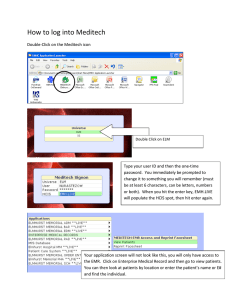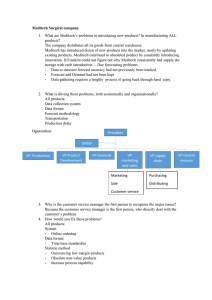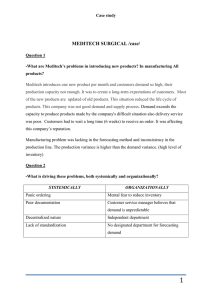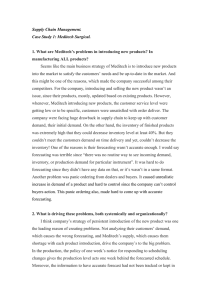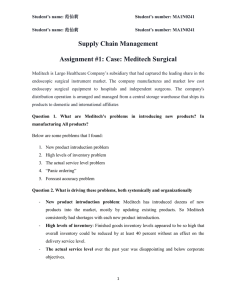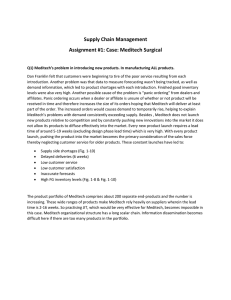CASE STUDY: 1 SUPPLY CHAIN AND MANGEMENT
advertisement
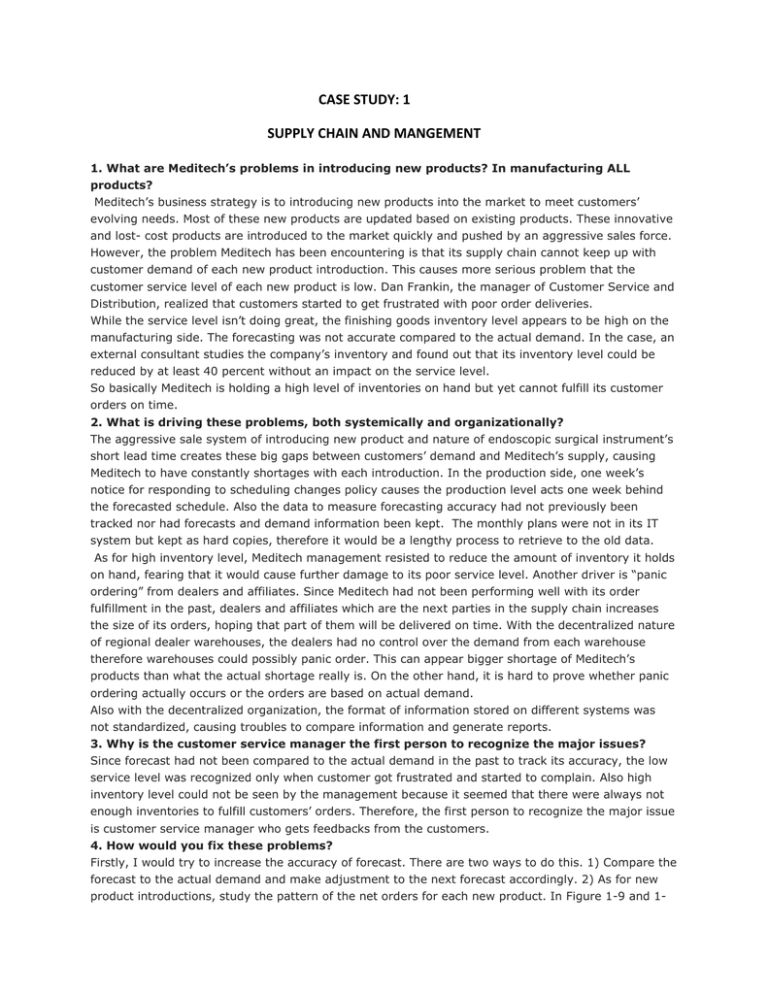
CASE STUDY: 1 SUPPLY CHAIN AND MANGEMENT 1. What are Meditech’s problems in introducing new products? In manufacturing ALL products? Meditech’s business strategy is to introducing new products into the market to meet customers’ evolving needs. Most of these new products are updated based on existing products. These innovative and lost- cost products are introduced to the market quickly and pushed by an aggressive sales force. However, the problem Meditech has been encountering is that its supply chain cannot keep up with customer demand of each new product introduction. This causes more serious problem that the customer service level of each new product is low. Dan Frankin, the manager of Customer Service and Distribution, realized that customers started to get frustrated with poor order deliveries. While the service level isn’t doing great, the finishing goods inventory level appears to be high on the manufacturing side. The forecasting was not accurate compared to the actual demand. In the case, an external consultant studies the company’s inventory and found out that its inventory level could be reduced by at least 40 percent without an impact on the service level. So basically Meditech is holding a high level of inventories on hand but yet cannot fulfill its customer orders on time. 2. What is driving these problems, both systemically and organizationally? The aggressive sale system of introducing new product and nature of endoscopic surgical instrument’s short lead time creates these big gaps between customers’ demand and Meditech’s supply, causing Meditech to have constantly shortages with each introduction. In the production side, one week’s notice for responding to scheduling changes policy causes the production level acts one week behind the forecasted schedule. Also the data to measure forecasting accuracy had not previously been tracked nor had forecasts and demand information been kept. The monthly plans were not in its IT system but kept as hard copies, therefore it would be a lengthy process to retrieve to the old data. As for high inventory level, Meditech management resisted to reduce the amount of inventory it holds on hand, fearing that it would cause further damage to its poor service level. Another driver is “panic ordering” from dealers and affiliates. Since Meditech had not been performing well with its order fulfillment in the past, dealers and affiliates which are the next parties in the supply chain increases the size of its orders, hoping that part of them will be delivered on time. With the decentralized nature of regional dealer warehouses, the dealers had no control over the demand from each warehouse therefore warehouses could possibly panic order. This can appear bigger shortage of Meditech’s products than what the actual shortage really is. On the other hand, it is hard to prove whether panic ordering actually occurs or the orders are based on actual demand. Also with the decentralized organization, the format of information stored on different systems was not standardized, causing troubles to compare information and generate reports. 3. Why is the customer service manager the first person to recognize the major issues? Since forecast had not been compared to the actual demand in the past to track its accuracy, the low service level was recognized only when customer got frustrated and started to complain. Also high inventory level could not be seen by the management because it seemed that there were always not enough inventories to fulfill customers’ orders. Therefore, the first person to recognize the major issue is customer service manager who gets feedbacks from the customers. 4. How would you fix these problems? Firstly, I would try to increase the accuracy of forecast. There are two ways to do this. 1) Compare the forecast to the actual demand and make adjustment to the next forecast accordingly. 2) As for new product introductions, study the pattern of the net orders for each new product. In Figure 1-9 and 1- 10, it seems that a new product demand falls into a pattern of reaching a high peak and becoming relatively stable immediately afterward. Therefore, Meditech can prepare for the peak by manufacturing more products before its production and decrease its production when demand falls down and becomes stable which is usually after the first two months. As you can see in Firgure1-10, the production was still increasing even though the actual demand dropped, which caused excess inventory on hand. Secondly, I would work with customers to increase the transparency along the supply chain. It is obvious that Meditech’s reputation is damaged by its poor delivery. That is why deals and affiliates started to panic order the production that can cause the bullwhip effect along the supply chain. Meditech would work with its customers to know what their real demands are. Here, it is not just the 1st tier customers like dealers and affiliates but also the 2nd tier customers such as the dealers’ regional warehouses. Communication can also be top-down: Meditech would provide more information to its customers about its new products in advance and have them pre-order the products so that forecasting and production scheduling can be easier Thirdly, I would work with Production Design department to design the instrument more flexible to allow new design easier to be implemented on the existing products. Since Meditech’s business strategy is to constantly introducing new products, the design of its product should be agile so that an update on the existing design will not cause a lot of major changes to its production and also to its supply chain. Last but not least, I would upgrade IT system for the company. In the past, the forecasts and demand information had not been kept and monthly plans had been hard copies only. Also there is inconsistency in terms of the format of data stored among different system. It would be great if a new IT system can store the forecasts and demand data with a standardized format in a central location so that management can utilize this information to generate reports and make managerial decisions for the company. VEERA DANI JOSEPH 0A40F005
